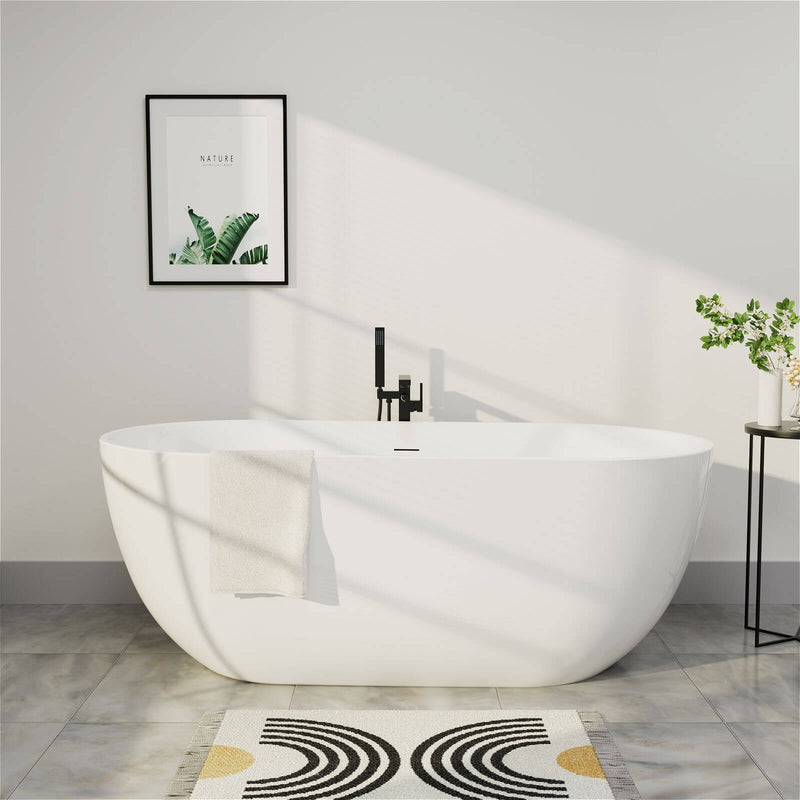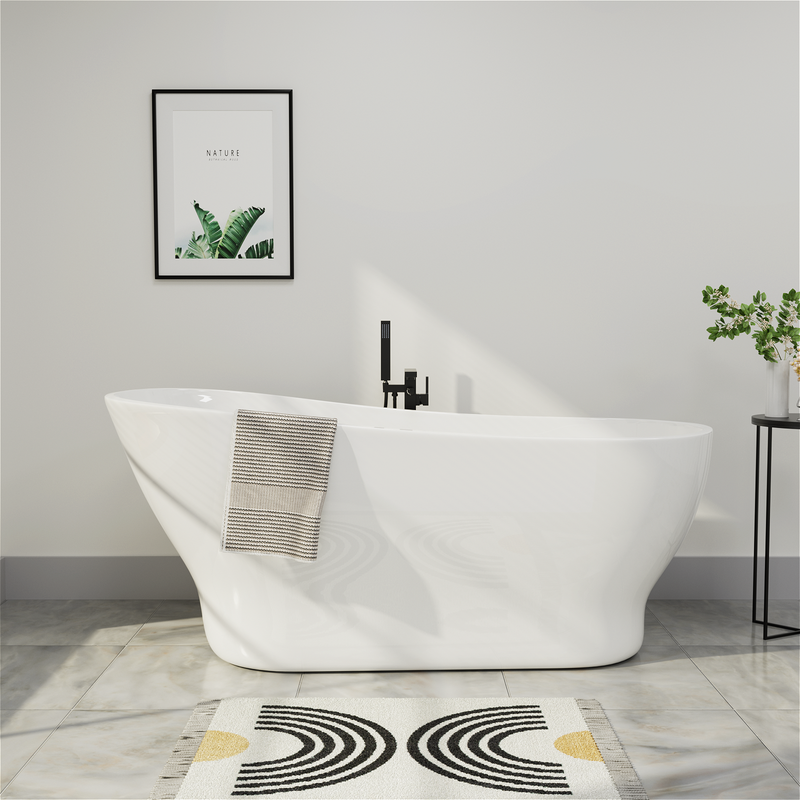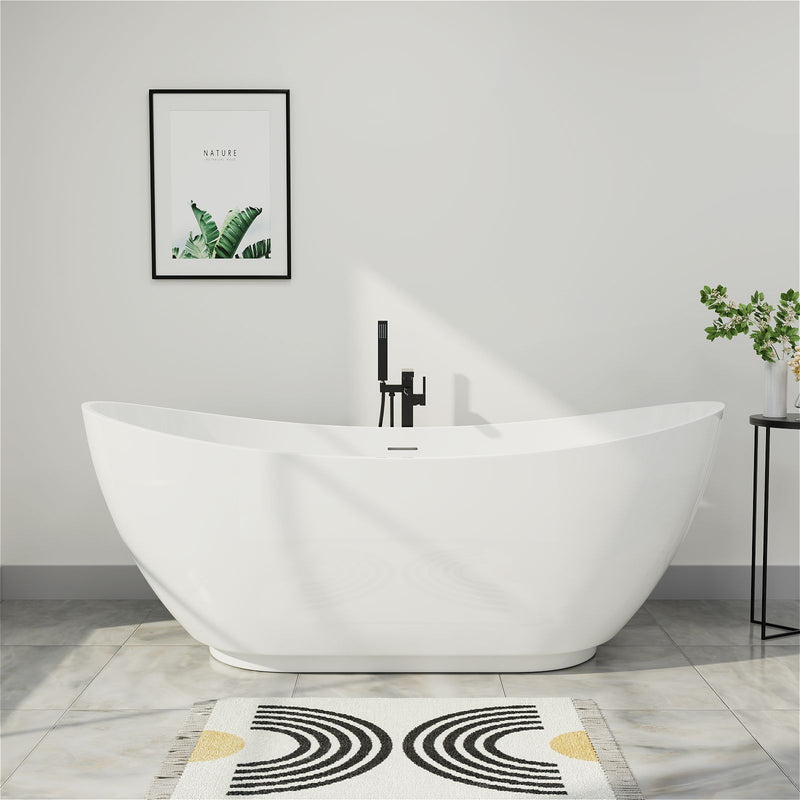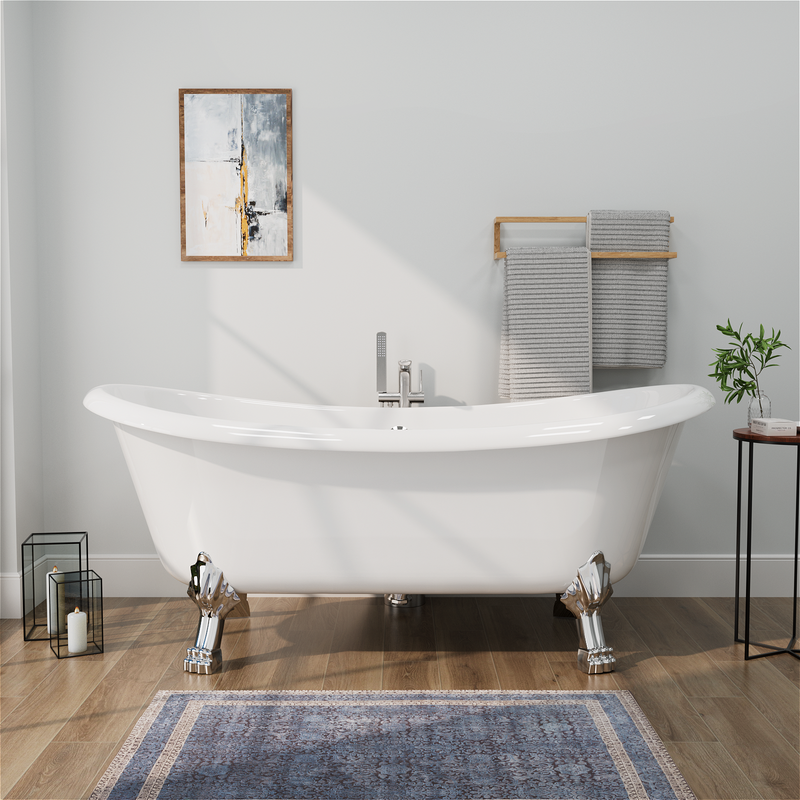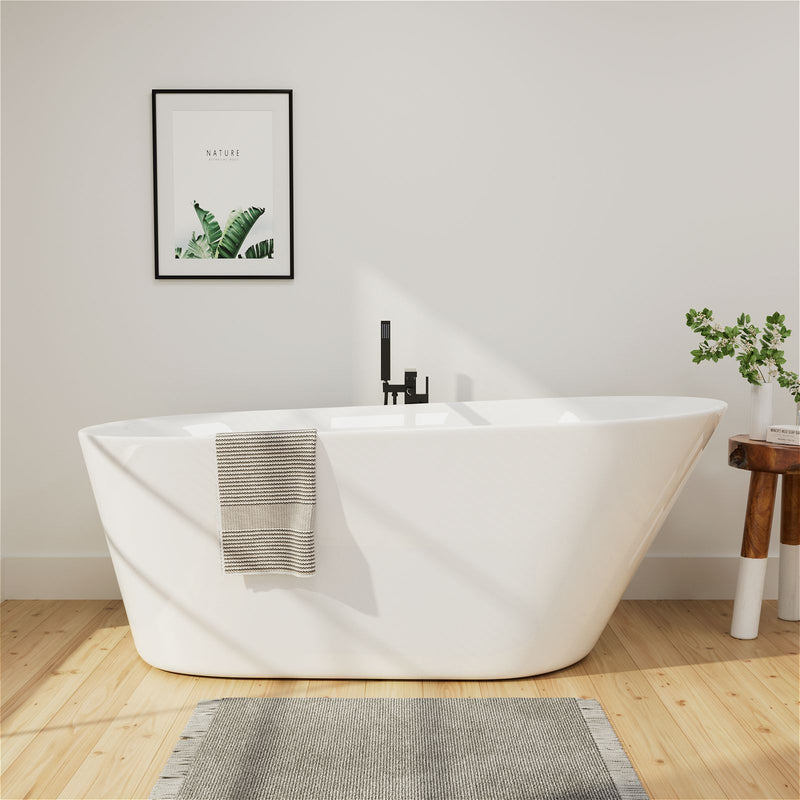Stepping into the shower in the morning, the icy cold base of the pan is a refreshing wake-up call - far from ideal. Even more worrying is the slippery surface, which can easily lead to a fall. And when you look down to discover lingering water, even your toes soaked in dirty water, even the most luxurious showerhead loses its meaning. The shower base, this often-overlooked detail, is central to bathing safety, comfort, and hygiene. Choosing the wrong base can ruin your mood at best or even endanger your safety at worst. Choosing the right one ensures a reassuring, warm, and dry shower every time.
From anti-slip performance and insulation to drainage slope design, this article will delve into the key factors to consider when choosing a shower pan base, helping you avoid common pitfalls and create a safe and worry-free shower space.
Anti-slip
Shower rooms are a high-risk area for slips and falls in the home. The base's anti-slip properties are directly related to personal safety and should be a top priority.

Material and Texture: Friction is Key
Natural Stone (Marble, Granite): While beautiful and luxurious, its naturally smooth surface can be extremely slippery when exposed to water! Be sure to choose a stone with a non-slip grooved or flamed finish, creating a uniform, uneven surface texture.
Artificial Stone (Quartz, Composite): Customizable non-slip patterns offer superior performance compared to natural stone, but the depth and density of the patterns should be carefully considered.
Acrylic/Fiberglass: The most common choice. These surfaces can be molded with fine, non-slip particles or wavy patterns, providing a soft touch and sufficient friction. When purchasing, feel the particles to ensure they are visible and evenly distributed.
Anti-slip Coating: Some products are sprayed with a transparent non-slip coating (such as silica sand). Verify the coating's wear resistance to prevent it from peeling off after a few months of use.
Pitfalls to Avoid:
Avoid choosing a pure, smooth, glazed ceramic base (commonly found on older shower trays), as they can be very sensitive to water.
Styles with too shallow or sparse textures (for decorative purposes only) offer virtually no anti-slip effect.
Drain Hole Design: Not Only For Drainage, But Also Affects The Footing
Placement: The drain hole should be located at the lowest point of the base, and the surrounding area should be relatively flat. Deep depressions around the drain hole can cause slipping and loss of balance when stepping on it.
Cover Safety: Metal or plastic drain covers should have anti-slip features (such as raised points or gratings) and be flush or slightly raised with the base to avoid becoming a stumbling block.
The Invisible Connection Between Slope and Slip Resistance
A scientifically designed drainage slope (described below) can quickly drain accumulated water, reducing the surface area of water film underfoot and indirectly improving anti-slip safety. The less accumulated water, the lower the risk of slipping.
Insulation
A cold bottom can quickly dampen your bathing passion. Insulation performance depends on the material properties and structural design.

Intrinsic Insulation of the Material
Cast Iron: The king of insulation! The material is thick and dense (high specific heat capacity), offering strong heat storage capacity. Once hot water is added, the bottom of the tray heats up quickly and maintains its temperature for a long time. However, its significant weight is a disadvantage.
Artificial Stone/Quartz: Its thermal insulation is second-best. Stone itself conducts heat slowly, allowing for a certain amount of heat storage, resulting in a milder sense of coolness than metal and ceramic.
Acrylic: Its thermal insulation is moderate. High-quality, thick-walled acrylic (≥5mm) offers some insulation, but lower-quality, thin-walled acrylic dissipates heat quickly. Its advantage is that it feels warm to the touch, not cold.
Stainless Steel/Ceramic: Its thermal conductivity is fast, but its thermal insulation is weakest. Once the water stops flowing, the bottom of the tray's temperature drops rapidly, making it easy to get cold feet.
Base Structure and Insulation Technology
Air Insulation: Some mid- to high-end bases utilize a double-layer structure, creating a sealed air layer between the bottom layer and the ground. Air is an excellent insulator, effectively preventing cold air from the ground from conducting upward.
Insulation Filling: Some shower trays feature insulation materials like polyurethane foam in the interlayer, significantly improving insulation performance. This is particularly suitable for bathrooms with cold floors.
Thickened Base: Material thickness directly impacts heat storage. Cast iron shower trays are recommended to be ≥5mm thick, while acrylic/artificial stone shower trays are recommended to be ≥12mm thick. The thicker the shower tray, the less cold it feels when stepped on, and the better the insulation.
Pitfalls to Avoid:
Ignoring the Installation Environment: If the shower tray is installed directly on a concrete slab without underfloor heating, consider an insulated or double-layered base.
Only Considering the Material and Ignoring the Thickness: Even the best material can be significantly less effective if it's too thin (such as low-quality, thin acrylic).
Drainage Slope
Stagnant water is a breeding ground for bacteria and a source of odor. An optimal drainage slope ensures that water flows smoothly toward the floor drain.
Slope Standard: Larger Is Not Always Better
Golden Range: The base surface should slope 1%-2% toward the drain (i.e., a decrease of 1-2 cm per meter).
Harmful Effects of Insufficient Slope (<1%):
Drainage is slow, resulting in puddles.
Soap scum and hair easily accumulate in these puddles, breeding bacteria and mold, making them difficult to clean.

Harmful Effects of Excessive Slope (>3%):
Standing up while showering can cause noticeable instability, requiring constant balance adjustments, resulting in a poor showering experience.
Excessive water flow may splash onto dry areas or prevent the drain from draining quickly enough.
Self-draining Capacity is a Key Criterion
Simulation Test: Request a sample or an on-site demonstration (some stores offer a hands-on area) when purchasing. Pour a small amount of water (e.g., 500ml) over the edge and observe:
Does the water flow freely, without splitting or backflow, toward the drain?
Does it drain completely within 10 seconds? Pay special attention to the corners and edges for any remaining water droplets.
Surface Curvature: A good base is more than just a tilted flat plate. Its surface should feature subtle guiding curves (such as a slightly raised center with a gentle slope converging around the edges), leveraging the surface tension of water to naturally guide it to the drain point.
Drain Position Matches the Base
Center Drain: The most common option. This requires a base slope that slopes evenly and symmetrically toward the center.
Side/Corner Drain: Suitable for space constraints or custom installations. The slope must be precisely aligned toward the side drain, requiring higher manufacturing precision.
Rectangular Floor Drain: The slope can be designed parallel to the base edge, creating a gutter effect for faster and more invisible drainage. Ensure that the base edge and floor drain are perfectly aligned with each other, with no height difference.
Pothole Avoidance:
Ignoring On-Site Measurements: When replacing a shower tray in an old house, be sure to accurately measure the existing floor drain location. The new base drain position must match it exactly; otherwise, extensive plumbing changes will be required (costly and prone to leaks).
Not Checking Installation Level: Always use a level to align the base during installation! Uneven installation will completely disrupt the original slope and cause water accumulation.
Material Safety and Durability
Slip resistance, thermal insulation, and drainage are obvious requirements, while material safety and durability are the more subtle cornerstones.
Environmental Protection and Health Safety
Low VOC Emissions: Pay special attention to whether the adhesives and resins used in artificial stone and composite materials meet environmental standards (such as the US GREENGUARD certification) to avoid the release of harmful gases under high temperature and humidity.
Antibacterial and Mildew Resistance: High-quality acrylic and specially treated quartz have dense, non-porous surfaces that are less susceptible to mold and bacterial growth. Inferior porous materials are prone to staining and mold.
Stain Resistance and Easy Cleaning
Dense Surface: Glazed ceramic, high-quality acrylic, and polished quartz have extremely small pores, making them impervious to soap scum and water stains, and they can be easily rinsed away with clean water.
Avoid Porous Materials: Unsealed natural stone and low-quality cement-based bases easily absorb soap and pigments, leaving permanent stains and requiring frequent sealing and maintenance.
Impact and Scratch Resistance
Acrylic: It has good toughness and can withstand minor impacts (such as a dropped soap dish), but its surface hardness is relatively low and easily scratched by sharp objects.
Artificial Stone/Quartz: It is hard and scratch-resistant, but relatively brittle and may chip and crack under heavy impact.
Cast Iron: The enamel surface is hard and wear-resistant, but heavy impacts may cause the porcelain to chip.
Installation and Maintenance
Excellent design requires proper installation and maintenance to achieve its full potential.

Professional Installation is key
Precise Leveling: Using a laser level to ensure the base is installed absolutely level is a prerequisite for effective drainage on slopes.
Sealing and Leak Prevention: The connection between the base and the wall and floor must be sealed with high-quality mildew-proof silicone. Pay special attention to waterproofing the floor drain connection.
Stable Support: Especially for heavy, large cast iron or artificial stone bases, ensure that the ground is sufficiently load-bearing and evenly supported to prevent deformation and cracking after long-term use.
Daily Cleaning and Maintenance Tips
Remove Hair Promptly: After each use, remove hair from the drain cover to prevent it from entering the pipes.
Mild Cleaner: Regularly wipe with a neutral detergent or baking soda solution to avoid strong acids and alkalis that can corrode the surface (especially damaging the acrylic gloss and stone sealant).
Avoid Scratching with Hard Objects: Do not use steel wool or hard brushes to clean the surface.
Unclogging the Drain: Regularly unscrew the drain cover to remove debris underneath and maintain drainage speed.
Conclusion
The shower tray base is more than just a supporting role in the bathroom. It bears the weight of your body during bathing and is crucial to your safety with every step. It determines the direction of water flow and influences the cleanliness of the space. The temperature that touches your skin influences your relaxation.
Key Principles of Selection:
Safety: The anti-slip texture must be effective and drain quickly to reduce the risk of slipping.
Comfort: Choose insulation materials and structures based on the environment (whether or not there is underfloor heating) to eliminate the irritation of cold feet.
Dryness: A strategic 1%-2% slope plus an excellent self-draining design eliminates the risk of water accumulation.
Durability: Eco-friendly materials, a dense, stain-resistant surface, and durability and ease of care ensure long-term comfort.
Avoid slippery traps, inadequate insulation, and improperly sloped surfaces with this guide. As warm water flows over your body, your feet feel a solid sense of security and just the right warmth, and the water quickly disappears without a trace - this is the foundation of a perfect bath and the reward of a wise choice.

